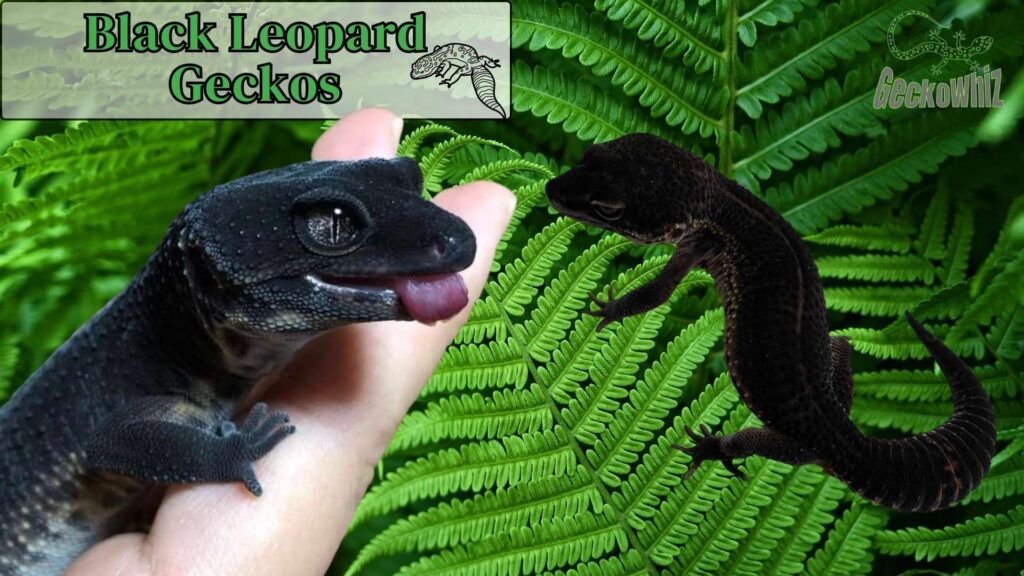Have you ever heard of a black leopard gecko? These unique reptiles are fascinating creatures that are known for their stunning black coloration. In this article, we will delve into the world of black leopard geckos and explore their origins, physical characteristics, unique features, and specific care requirements. We will also discuss the health concerns associated with these geckos and provide insights into breeding them. So, let’s get started and uncover the secrets of the mysterious black leopard gecko!## Understanding the Basics of Leopard Geckos

The Origin and Natural Habitat of Leopard Geckos
Leopard geckos, including the black variant, are native to the arid regions of Afghanistan, Iran, Pakistan, and parts of India. Their natural habitat consists of rocky desert terrain, where they seek shelter in crevices and burrows during the day to escape the scorching heat.
These fascinating creatures have adapted to survive in the challenging conditions of their environment. The arid regions they call home are characterized by extreme temperatures and limited water sources. To thrive in such harsh conditions, leopard geckos have evolved remarkable characteristics that allow them to conserve water and endure the arid climate.
One of the most remarkable adaptations of leopard geckos is their unique eyelids. These geckos have specialized eyelids that help protect their eyes from sand and dust. The eyelids are transparent and allow them to see even when their eyes are closed, providing them with an advantage in their rocky desert habitat.
In addition to their specialized eyelids, leopard geckos have developed the ability to store fat in their tails. This fat serves as an energy reserve during times when food is scarce. It allows them to survive for extended periods without consuming food and helps them endure the challenges of their arid environment.
Physical Characteristics of Leopard Geckos
Leopard geckos are small reptiles, typically reaching a length of 6 to 9 inches when fully grown. Their bodies are covered in smooth scales, which can vary in color and pattern depending on the gecko’s individual genetics.
While leopard geckos come in various colors and patterns, the black variant stands out with its striking jet-black coloration. This melanistic trait gives them a mesmerizing allure that sets them apart from other gecko morphs. Their intense black skin contrasts beautifully with their bright, beady eyes and often showcases stunning patterns, such as a thin white or silver outline around their eyes.
Leopard geckos also possess a unique ability to regenerate their tails. If a predator manages to catch their tail, the gecko can detach it as a defense mechanism. The detached tail will continue to wiggle, distracting the predator while the gecko makes its escape. Over time, the gecko will regenerate a new tail, although it may not be as long or as vibrant as the original.
The Unique Features of Black Leopard Geckos
Black leopard geckos are a fascinating and captivating morph of leopard geckos. Their striking black coloration sets them apart from other morphs and makes them highly sought after by reptile enthusiasts.
The Genetics Behind the Black Coloration
The black coloration in leopard geckos is a result of a recessive genetic trait known as melanism. Unlike other morphs where color variation is caused by dominant genes, the black morph requires both parents to carry the recessive gene to produce offspring with the captivating black coloration.
Understanding the genetics behind black leopard geckos can be an intriguing endeavor. Breeders and enthusiasts delve into the intricate world of genetic inheritance, carefully selecting and pairing geckos to produce offspring with the desired black coloration. It is a process that requires patience, knowledge, and a keen eye for genetic traits.
Through selective breeding, breeders have been able to create different variations within the black morph, such as high contrast patterns or subtle shades of black. This adds another layer of complexity and excitement to the world of black leopard gecko breeding.
Differences in Behavior and Temperament
While the black leopard gecko may look mysterious and exotic, their behavior and temperament are similar to those of other leopard gecko morphs. These geckos are generally docile and make excellent pets, especially for beginners.
Just like their counterparts, black leopard geckos are crepuscular, meaning they are most active during dusk and dawn. During these times, they come alive, exploring their environment and hunting for food. Their unique hunting technique involves using their keen eyesight to stalk and pounce on unsuspecting prey.
Feeding black leopard geckos is relatively easy, as their diet mainly consists of insects. Crickets and mealworms are commonly fed to these geckos and can be easily obtained from pet stores. Providing a varied diet ensures they receive the necessary nutrients to thrive and maintain their health.
When it comes to handling, black leopard geckos can become accustomed to human interaction with proper socialization. They may tolerate being gently held and enjoy exploring their surroundings under supervision. However, it is important to remember that each gecko has its own personality and comfort level with handling, so it is essential to approach them with care and respect.
Overall, black leopard geckos are not only visually stunning but also fascinating creatures to observe and care for. Their unique genetic traits and behavior make them a captivating addition to any reptile enthusiast’s collection.
Caring for a Black Leopard Gecko
Black leopard geckos are fascinating reptiles that require specific care to thrive in captivity. In this guide, we will explore the ideal living conditions, habitat setup, and dietary requirements for these unique creatures.
Ideal Living Conditions and Habitat Setup
Creating a suitable habitat for black leopard geckos is crucial for their health and well-being. One essential factor to consider is the tank size, as these geckos require enough space to roam, hide, and thermoregulate. A 20-gallon tank is usually sufficient for a single gecko, while larger enclosures should be provided for multiple geckos.
When setting up the tank, it’s important to replicate their natural environment as closely as possible. This includes providing a variety of hiding spots, such as rocks, caves, and log hides, where the geckos can retreat and feel secure. These hiding spots not only offer a sense of security but also mimic their natural habitat, which helps reduce stress.
Temperature regulation is crucial for black leopard geckos, as they are ectothermic creatures. To achieve this, it’s important to maintain a temperature gradient within the tank. This can be achieved by using an under-tank heating pad on one side of the tank and a heat lamp on the other side. The heating pad provides a warm basking spot, while the heat lamp helps create a cooler area for the geckos to retreat to when needed.
Humidity levels should also be monitored and maintained at around 30-40%. This can be achieved by misting the tank with water or using a reptile humidifier. Proper ventilation is essential to prevent the buildup of excess moisture, which can lead to respiratory issues.
Additionally, providing a calcium dish and a shallow water dish is crucial for maintaining proper hydration and mineral supplementation. The calcium dish should be filled with a calcium powder specifically designed for reptiles, while the water dish should be cleaned and refilled regularly to ensure a constant supply of fresh water.
Dietary Requirements and Feeding Schedule
Proper nutrition is vital for the health of black leopard geckos. Their diet primarily consists of live insects, which should be appropriately sized for their age and development. The most commonly fed insects include crickets, mealworms, and dubia roaches.
When feeding black leopard geckos, it’s important to ensure that the insects are gut-loaded with nutritious foods. Gut-loading involves feeding the insects a nutritious diet before offering them to the geckos. This ensures that the geckos receive a well-rounded and balanced diet.
Feeding should be done in the evening or early morning to align with their natural feeding patterns. Young geckos should be fed daily, while adults can be fed every other day. It’s essential to monitor their food intake and adjust the feeding schedule accordingly to avoid obesity or malnutrition.
Supplementation is also necessary to provide additional vitamins and minerals. This can be achieved by dusting the insects with a reptile-specific vitamin and mineral powder before feeding them to the geckos. It’s important to follow the recommended dosage to prevent over-supplementation.
Regularly monitoring the gecko’s weight and overall health is crucial to ensure they are receiving adequate nutrition. If any concerns arise, it’s best to consult with a reptile veterinarian who can provide guidance and advice tailored to your gecko’s specific needs.
Health Concerns Specific to Black Leopard Geckos
Common Health Issues and Their Symptoms
Like all reptiles, black leopard geckos are susceptible to certain health issues. Some common ailments to watch out for include metabolic bone disease, respiratory infections, and parasitic infestations. Symptoms may include lethargy, loss of appetite, difficulty breathing, or abnormal bowel movements.
Regular check-ups with a reptile veterinarian and maintaining proper husbandry practices can help prevent and address these health concerns effectively.
Preventive Measures and Treatments
To prevent health issues, it’s crucial to create a clean and hygienic environment for your geckos. Regularly clean the tank, remove any uneaten food, and ensure proper temperature and humidity levels.
If a health issue does arise, seeking professional assistance from a veterinarian with experience in reptile care is paramount. They can provide accurate diagnoses and recommend appropriate treatments to ensure your black leopard geckos are in optimal health.
Breeding Black Leopard Geckos
Understanding the Breeding Process
Breeding black leopard geckos can be a rewarding experience for seasoned gecko breeders. However, it’s essential to have a solid understanding of genetics and the specific requirements involved in breeding these geckos.
Successful breeding requires careful selection of breeding pairs, maintaining proper temperature and lighting conditions, and providing adequate nesting and egg incubation setups. The breeding process can take time and patience, but it can result in beautiful offspring with the coveted black coloration.
Potential Challenges and Solutions in Breeding
Breeding any reptile comes with its fair share of challenges, and black leopard geckos are no exception. Some potential challenges you may encounter include infertility, egg-binding, and complications during incubation.
Consulting with experienced breeders, conducting thorough research, and seeking guidance from reptile forums or communities can help you overcome these challenges and increase your chances of successful breeding.
Let your fascination with black leopard geckos lead you on an exciting journey into the world of these captivating reptiles. Whether you’re a beginner looking to introduce one into your pet family or an experienced breeder seeking to produce these stunning creatures, the world of black leopard geckos offers endless possibilities. Remember to provide them with the care, attention, and love they deserve, and they will reward you with their enchanting presence for years to come.
